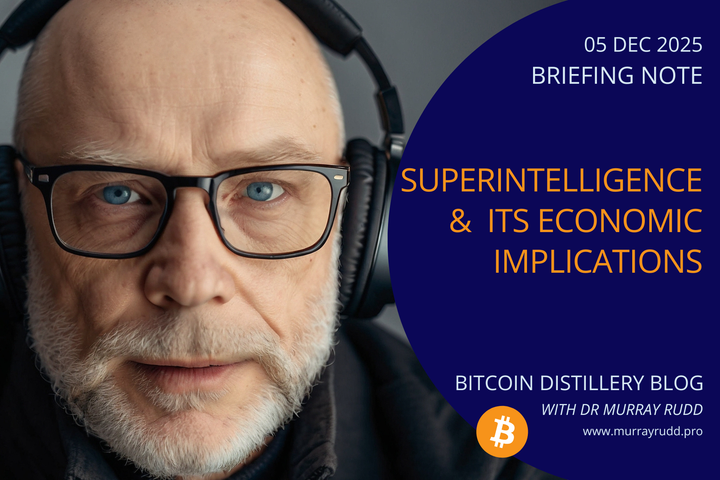Bitcoin’s Attention Economy and Institutional Adoption
The September 17, 2025 episode of the Robin Seyr Podcast features Joseph Voelbel explaining how Bitcoin’s scarcity and transparency are creating a new global “attention pocket.”

- My 'briefing notes' summarize the content of podcast episodes; they do not reflect my own views.
- They contain (1) a summary of podcast content, (2) potential information gaps, and (3) some speculative views on wider Bitcoin implications.
- Pay attention to broadcast dates (I often summarize older episodes)
- Some episodes I summarize may be sponsored: don't trust, verify, if the information you are looking for is to be used for decision-making.
Summary
The September 17, 2025 episode of the Robin Seyr Podcast features Joseph Voelbel explaining how Bitcoin’s scarcity and transparency are creating a new global “attention pocket.” He highlights how unit bias hampers retail adoption while institutional treasuries and financial products increasingly dominate exposure. Voelbel also underscores the balance between long-term holding, selective spending, and grassroots sovereignty through node operation.
Take-Home Messages
- Scarcity and Transparency: Bitcoin’s fixed supply and verifiability underpin its role as a new monetary focal point.
- Retail Hurdles: Unit bias deters small savers, making fractional ownership education essential.
- Institutional Drivers: Sovereign funds, endowments, and corporate treasuries are overtaking retail in adoption scale.
- Cultural Tensions: Bitcoiners face trade-offs between hoarding for future gains and spending to improve current quality of life.
- Corporate Strategies: Sustainable treasury models rely on cash-flow accumulation, while over-leveraged plays risk failure.
Overview
Joseph Voelbel describes money as an evolving system of “attention pockets,” where collective focus determines which units hold value. He places Bitcoin within this lineage, arguing that its scarcity and transparency distinguish it from fiat systems reliant on political discretion since 1971. His experience with local currencies convinced him that Bitcoin represents a scalable, non-extractive alternative with global reach.
He highlights unit bias as a persistent barrier for retail adoption, noting that many resist buying fractional amounts. In his view, institutional balance sheets, ETFs, and listed companies will eclipse retail as the dominant channel of adoption. Users may increasingly interact with Bitcoin indirectly, through financial products or applications that settle in sats in the background.
Culturally, Voelbel emphasizes the tension between saving for long-term appreciation and spending to enhance daily life. He advocates for selective spending on health, family, and personal enrichment once individual thresholds are met. This, he argues, reframes Bitcoin from an abstract ledger entry into tangible benefits that improve well-being.
Turning to corporate adoption, Voelbel distinguishes between sustainable cash-flow-backed strategies and leveraged balance-sheet plays. He notes the risks of overextended treasury models and predicts only a few firms will endure in this space. Alongside these corporate shifts, he observes rising interest in node operation as evidence of grassroots sovereignty and technical engagement.
Stakeholder Perspectives
- Retail savers: Seek simple, low-denomination entry points that reduce psychological barriers to fractional ownership.
- Institutional allocators: Rely on compliant financial products and treasury strategies to access Bitcoin at scale.
- Corporate treasurers: Balance accumulation strategies between cash-flow-funded purchases and higher-risk leveraged models.
- Regulators and policymakers: Monitor systemic risks from large institutional exposure and shifting market narratives.
- Developers and node operators: Build user-friendly interfaces that hide complexity while sustaining sovereignty options.
Implications and Future Outlook
Institutional adoption shifts the center of gravity away from retail, creating systemic exposure through pensions, sovereign funds, and endowments. This alters risk dynamics and places regulatory focus on concentration, leverage, and governance of corporate treasuries. The rise of indirect exposure also suggests that adoption may proceed with limited retail engagement.
Cultural and behavioral hurdles remain significant, with unit bias and psychological pricing shaping public perceptions. Overcoming these barriers requires education and product design that normalizes fractional ownership and incidental use. Without such interventions, Bitcoin risks entrenching a narrative of exclusivity despite broader access.
Treasury strategies will determine which firms endure market volatility. Cash-flow-positive approaches appear resilient, while highly levered strategies may collapse during downturns. These divergent paths will influence both public confidence and the credibility of Bitcoin-focused corporate models in the coming years.
Some Key Information Gaps
- How sustainable is Bitcoin’s position as a global “attention pocket” compared to historical reserve currencies? Assessing long-term resilience informs monetary policy and investment strategies.
- What educational tools best address retail misconceptions around unit bias and fractional ownership? Reducing barriers is critical for inclusive participation and broad distribution.
- To what extent will institutional adoption eclipse retail’s role in Bitcoin’s future growth trajectory? Measuring this shift clarifies systemic risks and concentration of exposure.
- Which treasury strategies—cash-flow positive, leveraged, or hybrid—are most sustainable under volatile conditions? Evaluating durability is essential for corporate governance and investor protection.
- How do PR campaigns and propaganda shape public perception of Bitcoin’s legitimacy? Understanding narrative influence supports informed policymaking and safeguards against manipulation.
Broader Implications for Bitcoin
Monetary Legitimacy Through Attention
Bitcoin’s framing as an “attention pocket” highlights that monetary legitimacy stems from collective focus as much as technical design. If global attention consolidates around Bitcoin, governments may need to adapt reserve management strategies that blend traditional assets with decentralized alternatives. This dynamic redefines how legitimacy is conferred in monetary systems.
Institutional Dominance and Systemic Risk
As institutional adoption eclipses retail, systemic exposure will increasingly mirror patterns seen in traditional finance. Concentrated holdings by sovereign funds, treasuries, and large corporates could amplify volatility and reshape regulatory frameworks. The broader implication is that Bitcoin may inherit the systemic risks of the financial institutions it aims to transcend.
Cultural Norms of Saving and Spending
The debate between hoarding and spending Bitcoin mirrors wider societal questions about financial security and quality of life. Normalizing selective spending challenges the “store only” mindset and situates Bitcoin within everyday economic activity. This cultural evolution could shift Bitcoin from niche asset to functional component of household financial planning.
Sovereignty Through Infrastructure
Rising interest in node operation signals a grassroots layer of financial sovereignty that parallels institutional adoption. As technical literacy spreads, decentralized infrastructure could reinforce resilience against censorship and control. This grassroots sovereignty provides a counterbalance to institutional concentration, anchoring Bitcoin’s decentralized ethos.



Comments ()